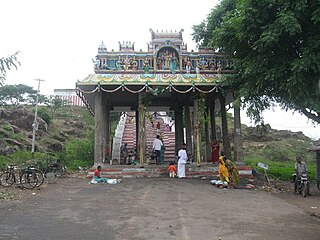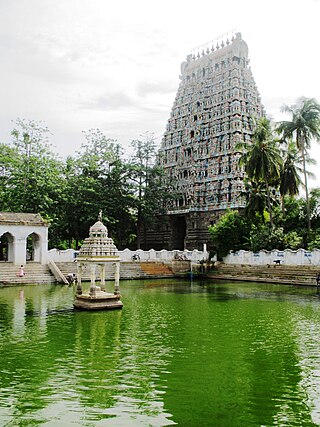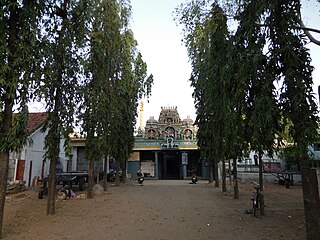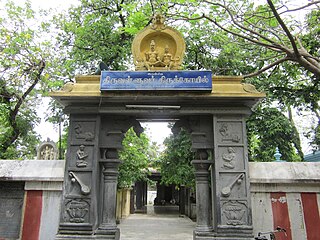
The Kapaleeshwarar Temple is a Hindu temple dedicated to the god Shiva located in Mylapore, Chennai in the Indian state of Tamil Nadu. The temple was built around the 7th century CE and is an example of South Indian Architecture.

The Srikalahasti Temple is located in the town of Srikalahasti, in Tirupati district in the state of Andhra Pradesh, India. According to regional tradition, it is said to be the site where Kannappa was ready to offer both his eyes to cover blood flowing from the Shivalinga before Shiva stopped him and granted him moksha. The inner temple was constructed around the 5th century CE and the outer temple was constructed in the 11th century by the Rajendra Chola I and other Chola emperors such as Rajaditya Chola, Rajaraja Chola I, Rajadhiraja Chola I, Kulottunga Chola I, Kulottunga Chola III, and Reddi kingdom,Vijayanagar Empire. The 120 feet (37 m) high main gopuram and the hundred pillared hall with intricate carvings was commissioned during the regime of the Vijayanagara Krishnadevaraya during 1516 CE. Shiva in his aspect as Vayu is worshipped as Kalahasteeswara. The temple is also regarded as Rahu-Ketu kshetra and Dakshina Kailasam.

The Vadakkumnathan Temple is an ancient Hindu temple dedicated to Shiva in Thrissur, in the Thrissur district of Kerala, India. The temple is a classical example of the architectural style of Kerala and has one monumental tower on each of the four sides in addition to a koothambalam. Mural paintings depicting various scenes from the Mahabharata can be seen inside the temple. The shrines and the Kuttambalam display vignettes carved in wood. The temple, along with the mural paintings, has been declared as a National Monument by India under the AMASR Act. According to popular local lore, this is the first temple built by Parashurama, the sixth avatar of Vishnu. Thekkinkadu Maidan, encircling the Vadakkumnathan Temple, is the main venue of the renowned Thrissur Pooram festival.

Kundrathur is a town located in the Chennai Metropolitan Area and the headquarters of Kundrathur taluk in Kanchipuram District. It is the birthplace of Sekkizhar, a well-known poet-saint who authored the Periyapuranam.

Marundeeswarar Temple is a temple dedicated to Hindu deity Shiva, located in Thiruvanmiyur, Chennai adjacent to the beach of Bay of Bengal. It is one of the 275 Paadal Petra Sthalams where two of the most revered Nayanars, Appar and Tirugnana Sambandar, have glorified the temple with their verses during the 7th century CE. The temple has been widely expanded by Chola kings during the 11th century CE. The temple has two seven-tiered gateway towers, a huge tank, with the overall temple area covering 1 acre. The Marundeeswarar temple has been a place of curative worship for people with diseases.

Mayuranathaswamy Temple, Mayiladuthurai or Mayuranathar Temple is a Hindu temple in the town of Mayiladuthurai in Tamil Nadu, India. The temple is dedicated to Lord Mayuranathaswamy, a form of Shiva, and has given its name to the town itself. The main icon is a lingam and the presiding deity is called Mayuranathar because the Hindu goddess Parvathi worshipped Shiva here in the form of a mayura.

Sivagurunathaswamy templeis a Hindu temple dedicated to Shiva located in the village of Aduthurai, Tamil Nadu, India. Shiva is worshipped as Sivagurunathaswamy, and is represented by the lingam. His consort Parvati is depicted as Prabhavalli. The presiding deity is revered in the 7th century Tamil Saiva canonical work, the Tevaram, written by Tamil saint poets known as the nayanars and classified as Paadal Petra Sthalam.

Kachchaleswarar Temple, also known as the Great Kachali Pagoda, is a Hindu temple located in Armenian Street, in the neighbourhood of Parry's corner in Chennai city, Tamil Nadu, India. Constructed on land belonging to dubash Kalavai Chetty in 1725, the temple belonged to the left-hand castes and was the site of the first major conflict between left and right-handed castes in the then Madras city.

The Ekambareswarar–Kamakshi Temple, commonly known as the Thiruvalluvar Temple, is a Hindu temple dedicated to the poet-saint Valluvar in the neighborhood of Mylapore in Chennai, India. The shrine is located within the Ekambareswarar temple complex. Believed to have been constructed in the early 16th century, the temple was extensively renovated in the 1970s. Traditionally believed to be the birthplace of Saint Valluvar, the temple is the oldest ever built to Valluvar. The temple also serves as the venue for meetings of Tamil language enthusiasts and conducting Kural classes. While many consider the temple as the birthplace of Valluvar, some additionally consider it as his samadhi.

Karaneeswarar Temple is a Hindu temple located in the neighborhood of Saidapet in Chennai, India. It is dedicated to Shiva. This is an ancient Temple presently managed by the HR & CE department of the Government of Tamil Nadu. The Goddess is known as "Swarnambika". Apart from this, there are separate shrines for Lord Ganapathi, Lord Karthikeya and other Parivara Devtas. This temple is located next to the Saidapet Railway station.

Velleeswarar Temple is a Hindu temple in Mylapore, Chennai, Tamil nadu, India. The presiding deity is Shiva as Velleeswarar. This mid-sized temple, spread over 2 acres is one amongst the Seven Shiva Temples of Mylapore. It is situated at South Mada Street, closer to Kapaleeswarar Temple.
Velleeswarar Temple is a Shiva temple located in Mangadu, a suburb of Chennai, India. This is a mid-size temple spread over 2 acres and is among the 3 principal temples in Mangadu – the other 2 being the Sri Kamakshi Amman Temple and Sri Vaikunda Perumal Temple. The temple is managed by the HRCE Department of the Government of Tamil Nadu. It is situated about 2 kilometers from Sri Kamakshi Amman Temple in Mangadu.

Anna Nagar Ayyappan Koil is a Hindu Ayyappan Temple dedicated to the deity Ayyappan in Chennai, India. It is located at the junction of 6th Main Road and 2nd Avenue in Anna Nagar.

Vayilar, also known as Vayilan, Vayila Nayanar, Vayilar Nayanar and Vayilar of Mayilai, was a Nayanar saint, venerated in the Hindu sect of Shaivism. He is generally counted as the fifty-first in the list of 63 Nayanars. He is said to worshipped the god Shiva, his patron, by his Mind and built a grand temple for him in his mind.
Kuzhanthai Velappar Temple is a Hindu temple in the village of Poombarai near Kodaikanal in Dindigul.
Elumur Ardhanareeswarar Temple is a Siva temple in Egmore in Chennai in Tamil Nadu (India). It is one of the shrines of the Vaippu Sthalams sung by Tamil Saivite Nayanar Appar.

Tirttapaleeswarar Temple is a Hindu temple located in Triplicane in Chennai, India. It is dedicated to Shiva as Tirttapaleeswarar.

Virupakshiswarar Temple is a Hindu temple located in Mylapore in Chennai, India. It is dedicated to Shiva.

Valeeswarar Temple is a Hindu temple located in Mylapore in Chennai, India. It is dedicated to Shiva.

Malleeswarar Temple is a Hindu temple located in Mylapore in Chennai, India. It is dedicated to Shiva.

















